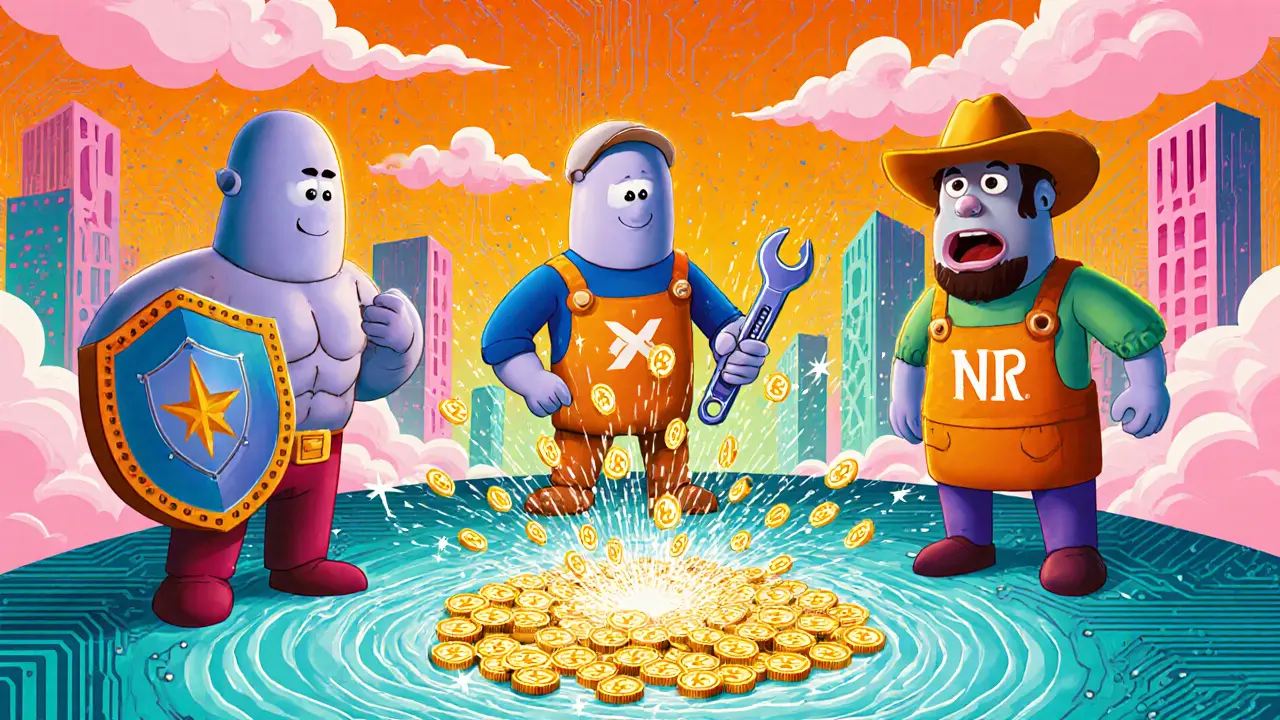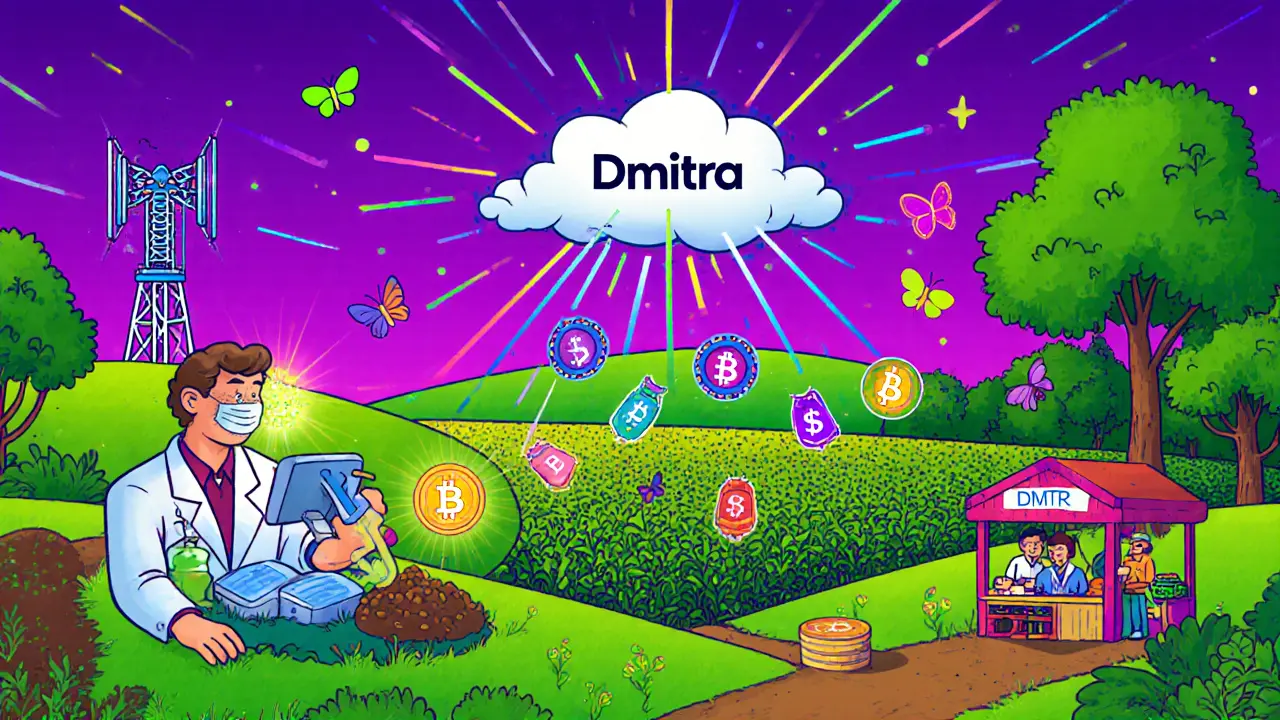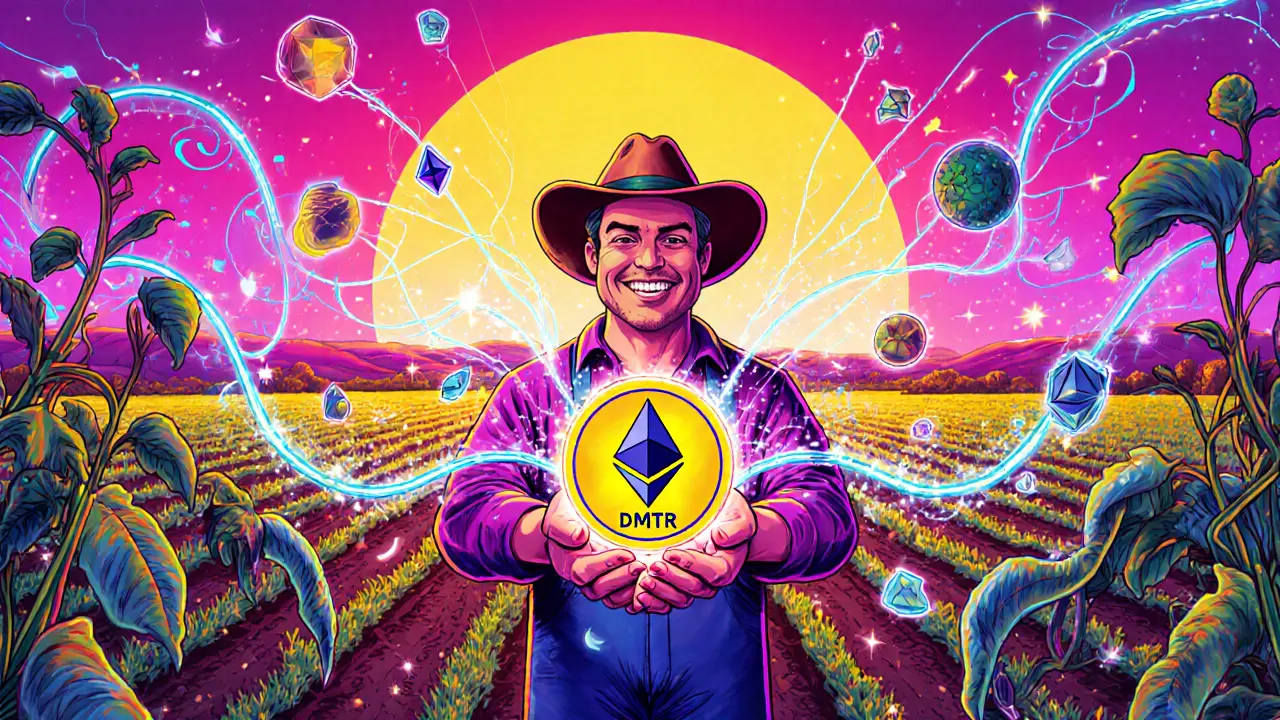DMTR Staking Calculator
Staking Earnings Estimator
Estimate your potential returns from staking DMTR tokens based on the current yield.
Dimitra (DMTR) is an Ethereum‑based utility token that aims to bring blockchain, AI and IoT to smallholder farmers around the globe. Launched in July 2021 by Jon Trask, DMTR lives on the Ethereum network as a standard ERC‑20 token and powers an ecosystem that lets farmers pay for services, earn carbon credits and even stake their holdings for passive income. If you’ve ever wondered what makes DMTR different from Bitcoin or Ethereum, this guide breaks down the tech, the tokenomics, real‑world uses and the current market picture.
How the Dimitra Network Works
At its core, DMTR runs on the Ethereum blockchain, which means every transaction is transparent, immutable and can be verified on Etherscan. The token follows the ERC‑20 standard, so any wallet that supports Ethereum can hold DMTR - from popular mobile apps like MetaMask to hardware solutions such as Ledger.
Unlike pure proof‑of‑work chains, Dimitra uses a Proof‑of‑Stake (PoS) consensus. Token holders can lock up (stake) a portion of their DMTR to help secure the network and, in return, earn a share of transaction fees. About 17% of the total supply is earmarked for staking rewards, paid out monthly but capped daily to keep the system sustainable.
The network is built around three node types:
- Full nodes - verify transactions, run the PoS algorithm and relay data across the network.
- Test nodes - used for development and trial runs before new features go live.
- Community nodes - run by farmers or local cooperatives, allowing them to participate directly in the ecosystem.
Full node operators earn modest fees based on the volume they process, giving a financial incentive to keep the network healthy.
Tokenomics: Supply, Distribution & Staking
When DMTR was created, the team minted 8,254,360 tokens as an initial batch. The roadmap calls for a maximum supply of 1 billion tokens over the next 20 years, with new tokens released gradually to avoid inflation shocks.
As of October 2023, roughly 486,503,181 DMTR were in circulation, according to KuCoin data. The circulating supply makes up about 48.6% of the eventual cap, leaving room for future growth and ecosystem incentives.
Key distribution points include:
- Staking pool - 17% of total supply allocated for rewards.
- Team & advisors - locked for three years to align long‑term interests.
- Community & partnership programs - used to fund the Mexico Carbon Project and other AgTech pilots.
- Public sale - initial tokens sold on exchanges like KuCoin, Gate.io and Bitget.
Staking works like this: you lock a chosen amount of DMTR in a smart contract, the network validates your stake, and you receive a proportional share of the fee pool each month. The current annual yield hovers around 8-10%, though exact returns depend on network activity and the daily cap.
Real‑World Use Cases in Agriculture
What really sets DMTR apart is its focus on agriculture. The token isn’t just a speculative asset; it’s a payment method for concrete services:
- Soil testing - farmers can pay for lab analyses using DMTR, getting faster results through the platform’s AI diagnostics.
- Crop monitoring - IoT sensors upload data to the Dimitra cloud, and the service fee is settled in DMTR.
- Carbon credit trading - the Mexico Carbon Project lets token holders earn verified carbon credits, which can be sold on secondary markets for additional profit.
- Micro‑loans - partner cooperatives offer short‑term loans denominated in DMTR, reducing reliance on traditional banking.
Because every transaction is recorded on‑chain, farmers gain a transparent ledger of expenses, revenues and sustainability metrics - a big step up from cash‑only bookkeeping.
Market Snapshot (October 2025)
DMTR’s price has been volatile. In early 2023 values ranged from $0.029 to $0.089, reflecting differing reporting dates and exchange liquidity. By October 2025 the token trades around $0.045 on major platforms, giving it a market capitalization of roughly $45 million. While that’s small compared to Bitcoin’s multi‑trillion market cap, it places DMTR in the “small‑cap” crypto tier with high growth potential.
Key exchanges listing DMTR include:
- KuCoin - highest daily volume, supports both spot and futures.
- Gate.io - offers staking directly on the exchange.
- Bitget - provides leveraged trading pairs for advanced users.
Liquidity remains a challenge; large trades can move the price noticeably, a point often raised by community members on Reddit and Discord. However, the 95% bullish sentiment reported by Bitsgap in 2023 suggests confidence among active traders.
Community, Resources & How to Get Started
If you want to own DMTR, the first step is a compatible wallet. Any Ethereum ERC‑20 wallet works - MetaMask, Trust Wallet, Ledger, or even a paper wallet if you’re extra cautious. After acquiring some ETH for gas fees, you can swap for DMTR on KuCoin or Gate.io.
Community channels are lively:
- Telegram - ~15,000 members discuss staking, upcoming farms and technical updates.
- Twitter/X - 28,500 followers receive project announcements and partnership news.
- Official docs on dimitra.io cover everything from node setup to API integration.
For newcomers, the platform’s own “Getting Started” guide walks you through wallet setup, token purchase and staking in under 10 minutes.

Risks, Challenges & What to Watch
Every crypto investment carries risk, and DMTR has a few unique ones:
- Adoption rate - the token’s value hinges on real farmers using the platform. Slow uptake in rural areas with limited internet could curb growth.
- Regulatory landscape - carbon credit markets and crypto regulations differ country‑by‑country. Changes in policy could affect the Mexico Carbon Project’s compliance.
- Liquidity - as mentioned, large orders can cause slippage, making it harder to exit positions without affecting price.
- Technology scaling - handling high‑frequency sensor data on Ethereum may become costly if gas prices surge, although Layer‑2 solutions are being explored.
Keeping an eye on roadmap milestones - especially the rollout of real‑time crop monitoring and expanded carbon‑credit integrations - will give clues about future demand.
Quick Comparison: DMTR vs. Other Utility Tokens
| Token | Primary Focus | Staking Yield | Market Cap (USD) | Key Use Case |
|---|---|---|---|---|
| Dimitra (DMTR) | Agri‑Tech & Carbon Credits | 8‑10% APR | ~45 M | Pay for soil tests, earn carbon credits |
| Casper (CSPR) | General‑purpose blockchain | ~5% APR | ~250 M | Smart contract platform |
| Alchemy Pay (ACH) | Payments & fiat‑crypto bridge | ~6% APR | ~90 M | Retail payments |
The table shows that DMTR’s niche is far narrower than a generic blockchain token, but that specialization gives it a clear real‑world hook - something many utility tokens lack.
Bottom Line
If you’re looking for a crypto project that does more than chase price, DMTR offers a concrete mission: bring blockchain‑enabled services to farmers and create a market for verified carbon credits. Its tokenomics are transparent, staking is reasonably rewarding, and the community is active. The main hurdles are adoption speed and liquidity, so treat DMTR as a medium‑to‑long‑term play rather than a quick flip.
What blockchain does DMTR run on?
DMTR is an ERC‑20 token built on the Ethereum network, which means it inherits Ethereum’s security and can be stored in any Ethereum‑compatible wallet.

How can I earn staking rewards with DMTR?
Lock your DMTR in the official staking contract (or use an exchange that offers DMTR staking). You’ll receive a share of the transaction‑fee pool each month, typically yielding 8‑10% annually.
Where can I buy DMTR?
Major exchanges listing DMTR include KuCoin, Gate.io and Bitget. After creating an account, you can trade fiat or crypto pairs for DMTR.
What is the Mexico Carbon Project?
It’s a DMTR‑backed initiative that generates verified carbon credits through forest conservation in Mexico. Token holders can earn or purchase these credits and trade them on secondary markets.
Is DMTR a good long‑term investment?
DMTR’s success depends on how quickly farmers adopt the platform and on the growth of carbon‑credit markets. If those trends continue, the token could see solid appreciation; otherwise, price volatility may remain high.

Write a comment